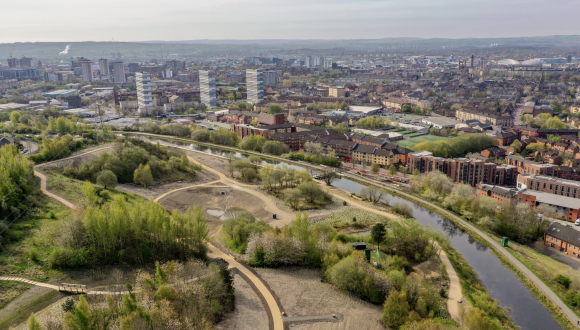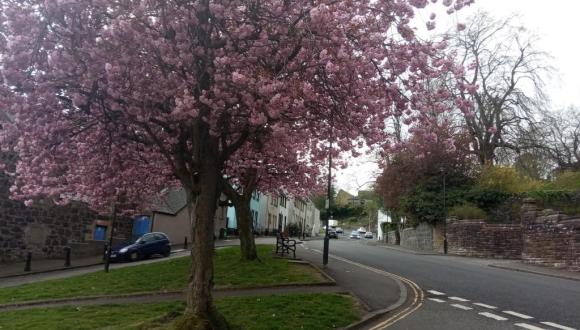Wilding our Parks case study - West Lothian report
Bog Garden creation as part of drainage solutions in Falcon Brae Park, Livingston
Site: Falcon Brae Park
Location: 55.895587, -3.530902
Site type: Bog garden
Secondary type: Public parks & gardens, Amenity greenspace
Management responsibility: West Lothian Council
Naturalisation types: Watercourse naturalisation, Native wildflower meadow, Pond margin/marsh
Links
West Lothian Council’s Parks Gardens and Open Spaces information
Tags/Themes
Wetland, Sustainable urban drainage, Biodiversity
Thumbnail introduction
An experimental bog garden, the learning from which is providing guidance to the council team addressing drainage issues in other parks with clay soils.
Introduction
West Lothian soils have a high clay content, and as a result, most of the area’s parks have drainage issues. As part of wider improvements to Falcon Brae Park, an experimental bog garden was created to see if it would address waterlogging. The work took place during 2020/21 as part of West Lothian Council’s ongoing capital programme. Whilst upgrading drainage in the park, a suitable site within the grassland, and near hedging, was used to create the bog garden. It is one of the first bog gardens created by the council, and the learning is being used to improve its effectiveness as well as to provide protocols for similar solutions in other West Lothian parks.
Drivers for naturalisation
- To explore bog gardens as a solution to sustainable urban drainage within parks
- To enhance biodiversity and ecosystem services
- To respond the community’s desire for more variety in the park, through providing a more varied landscape, and a wider range of flowers and insects
What has been delivered?
An oval basin of 6m x 8m has been excavated to a maximum depth of about 30cm. An inlet was created leading from path drainage at a higher elevation. The overflow outlet, higher than the basin inlet, allows the water to enter a manhole and mains drainage in the corner of the park.
Marginal plants were put directly into the clay soil. 450 plants of 14 species were planted. The final mix of plants included more species, and a smaller quantity per species, than was originally planned, as it was influenced by what was available from commercial suppliers in the timeframe required.
Enhancement work is currently taking place, using the experience of two years, in which one spring was extremely dry. Topsoil is being added, which will dry out slower than clay, and restocking is taking place. The species list now includes plants that have coped with the conditions and can compete with plants that colonise naturally.
Appendix 1 lists the species planted in 2020 and in spring 2022.
How was it done and by whom?
The council’s Open Space Officer instigated and carried out the project, with drainage advice from the council’s Flood Risk Management team.
The company contracted for the wider park improvements (Bennie Contracts Ltd) excavated the basin.
Local residents helped with signage ideas, which were developed by a graduate placement within the Ecology and Biodiversity Team.
Communication and engagement
The full park improvement works in Falcon Brae Park took place as part of the council’s ongoing open space capital programme. Prior to these works, the Community Regeneration Team consulted the community. Feedback included requests for a greater variety of things to do in the park, improved drainage and more planting. The resulting plan included paths for easier access and wheeled play (e.g. scooters), two benches, a bin, drainage and signage.
How is it looked after and maintained?
Once the current enhancements are complete and established, the bog garden should be maintenance free. The bog garden is located in an informal area of the park near a cornus (dogwood) hedge with woodland nearby, and over time it will be colonised by plants suited to that environment.
Cost of the project
The complete park improvements cost £37,000 for a perimeter asphalt path, link path through the woodland, drainage and bog garden, bin, benches, fencing and signage.
The total cost for the bog garden is estimated to be £4750.
Breakdown of the budget for bog garden establishment in 2020:
- £750 contractor excavation works (as part of total drainage works in the park of £6600)
- £1500 planting and delivery
Budget spend for bog garden enhancement in 2022:
- £2500 for plants, topsoil, replanting and A3 signage
Issues and challenges
The council wanted to avoid using plastic to line this (and future) bog gardens. They found the clay dried out too much in an extended period of very dry weather, killing some of the plants, so they are testing use of topsoil, together with planting more of the species that survived extreme conditions.
The council was unable to source plants locally, in the numbers and within the timescale required, and so they were sourced in Hertfordshire from Wetland Plants.
Learning and advice
Use of signage to explain what is happening and why the change is important is essential, particularly at areas that do not immediately look finished. This message is for the community, as well as for operatives who may feel the area needs to be cut or sprayed to stay in keeping with more formal areas.
“We are learning by doing. Timing is important to give plants the best chance to establish. We have learnt that many plants of a few key species are best – you need the drama from swathes of one colour, and they need to compete with the ‘weeds’. And you probably need more plants than you think!”
Becky Plunkett, Ecology and Biodiversity Officer, West Lothian Council.
Next steps
The team will continue to monitor this bog garden and extend use of them across other sites in West Lothian. The use of sensors to monitor water levels in bog gardens is being explored, and two new sites are currently being planned in other parks.
West Lothian Council has created an Ecology and Biodiversity Team to advance the conservation and enhancement of biodiversity throughout the area and to support their Climate Change policies, including this sort of work.
Project contact
Becky Plunkett, Ecology and Biodiversity Officer, West Lothian Council.
|
Quantity of plants |
Plant species |
Did they survive? |
|---|---|---|
|
30 |
Iris pseudacorus (yellow flag iris) |
Yes |
|
40 |
Lythrum salicaria (purple loosestrife) |
Yes |
|
45 |
Ranunculus lingua grandiflora (greater spearwort) |
No |
|
25 |
Mentha pulegium (pennyroyal) |
Yes |
|
25 |
Preslia cervina (water spearmint) |
Yes |
|
30 |
Myosotis scorpioides (water forget-me-not) |
Yes |
|
50 |
Carex elata 'Aurea' (bowles golden sedge) |
1 or 2 plants |
|
45 |
Butomus umbellatus (pink flowering rush) |
No |
|
25 |
Iris louisiana 'Black Gamecock' |
Yes |
|
25 |
Iris Louisiana 'Arabian bayou ' |
Yes |
|
30 |
Baldellia ranunculoides (lesser water plantain) |
No |
|
25 |
Veronica beccabunga (brooklime ) |
Yes |
|
30 |
Scirpus cernuus (fibre optic plant or Cotton bud grass ) |
1 plant |
|
25 |
Typha minima (dwarf bulrush ) |
No |
|
450 |
TOTAL |
|
2022 establishment planting:
|
Quantity of plants |
Plant species |
|
20 |
Iris pseudacorus 'Alba' (ideally white iris, or yellow iris) |
|
30 |
Lythrum salicaria 'Robert' (purple loosestrife - compact variety) |
|
40 |
Myosotis scorpioides (water forget-me-not) |
|
40 |
Mentha aquatica (water mint) |
|
40 |
Caltha palustris (marsh marigold) |
|
30 |
Filipendula ulmaria (meadowsweet) |
|
seeds |
Geum rivale (water avens) - seeds collected from plants alongside the River Almond in Livingston |
|
200 |
TOTAL |





